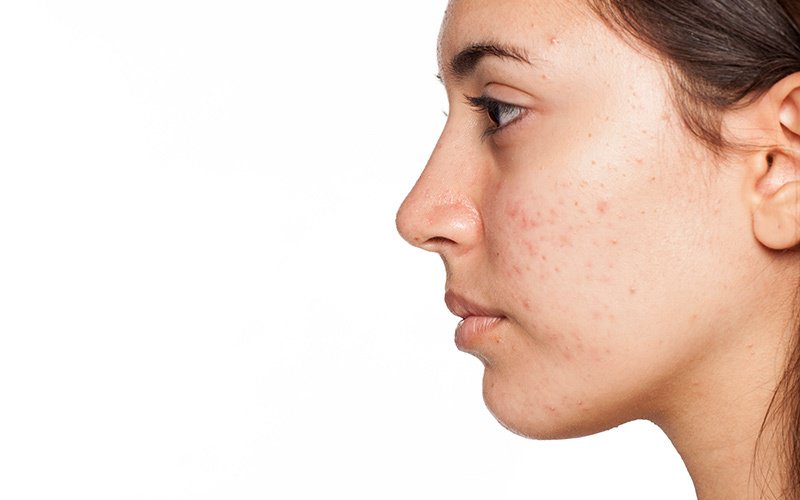Acne can occur at any age. While it is most common in teenagers — some 90% of adolescents get it — it can also affect adults. Regardless of when it strikes, it can leave scars and, for those who have to live with such scarring, it can cause embarrassment, poor self-image, and even social withdrawal.
While treating acne early on can help prevent scarring, there’s really no way to tell who will have scars and who won’t.
“When you have severe acne, it can damage the dermis and lower layers of the skin tissue,” says Dr. Neeraja Mattay, a board-certified dermatologist at U.S. Dermatology Partners Centreville, formerly Dermatology Associates of Northern Virginia. “This creates scarring and can even cause keloids, which are raised scar tissue.”
Fortunately, today there are treatments that can help smooth the skin and reduce the appearance of skin damage. While some over-the-counter topical treatments can help reduce light scarring, more severe damage — such as raised scars and discoloration — will probably require treatment from a dermatologist.
“Not all types of scars respond to treatments the same way,” Dr. Mattay says. “It’s important to work with someone who understands the different types of scarring and how each treatment can be beneficial.”
Here’s a look at some of the treatments that can help get rid of acne scars. Keep in mind that different types of acne will call for different types of treatments and often will require more than one visit. The number of visits you need will depend on how severe your scarring is and how well your skin responds to the procedure, but your dermatologist can work with you to create a personalized treatment plan.
Platelet-Rich Plasma Therapy
More commonly known as PRP, platelet-rich plasma therapy is effective for treating acne scarring because it helps regenerate the collagen and elastin in the skin, creating new cells that cause the skin to plump up and smooth out the appearance of scars. PRP uses a serum made from your own blood to reverse depressions in the skin and encourage the flow of blood, oxygen, and nutrients.
Microdermabrasion
Microdermabrasion has become a popular procedure for many different skin conditions and for people of all ages. It uses a device to create gentle abrasion on your skin, which breaks up dead skin, exfoliates it and buffs the surface. Better circulation and blood flow make for improved texture and appearance.
It can take more than one treatment to achieve the results you’re looking for, but there are also minimal side effects.
Microneedling
Also known as Collagen Induction Therapy (CIT), microneedling is an effective treatment for acne scars. Using a super-fine needle to poke holes in your skin, it creates a small injury that encourages the body to create new collagen. This collagen production can fill in depressed areas in the skin and give your skin a smoother, plumper surface overall.
Chemical Peels
Chemical peels cause the skin to blister and, when the blistered skin peels off, reveal a fresh, smooth layer of skin. They are often used to treat fine lines and signs of aging skin, but they can be an effective treatment for acne scars because they remove the skin’s scarred surface and allow healthy skin cells to replace them.
Peels work best on people with fair skin, as the peels can sometimes cause uneven skin coloring. If you have darker skin, you’ll want to talk with your doctor to see if this is your best option.
CO2 Laser Resurfacing
CO2 laser resurfacing can help remove acne scars and is generally considered more effective than treatments like chemical peels and microneedling. The carbon dioxide laser vaporizes layers of the skin with a high-intensity beam of light, which encourages the skin to create collagen to “heal” the injury. This creates a smoother, even surface on the top layer of the skin and, over a period of a few weeks, your skin continues to improve as the healing progresses.
This procedure requires some downtime, as the treated area will need to be covered with a dressing for about 24 hours. Full recovery typically takes one to two weeks, and you’ll need to avoid sunlight and skin irritants for the first few days.
Fraxel
Fraxel laser skin resurfacing uses fractional laser technology to help restore your skin’s original smooth texture. That means the lasers penetrate the skin’s surface and stimulate the body’s own healing process, so it can produce collagen to replace the scarred and damaged skin. Your skin will be sensitive to the sun and to certain skin care products after treatment, so follow your dermatologist’s skincare guidelines to the letter.
Dermal Fillers
Using dermal fillers is a great way to reduce the appearance of acne scars. The fillers will lift the depressed scars and improve their appearance, although the effect is temporary — it can last anywhere from six months to a year. Some of the popular fillers for treating acne scars include Belotero, Restylane and Juvederm. These fillers can also be used in conjunction with another treatment, such as Fraxel or chemical peels, to improve the overall look and condition of the skin.
Broad Band Light Photofacial
Broad Band Light, or BBL, photofacials use light and energy to improve acne scarring. The lasers focus on a specific area of the skin, heating deeper layers and causing the skin to stimulate collagen production for smoother skin.
Omnilux
Another form of light therapy, Omnilux uses narrow-band wavelength lights delivered to the skin in a timed sequence as a way to stimulate cell growth. Multiple treatments are needed, and each treatment takes about 30 minutes. There’s no downtime involved, and it can be used in conjunction with other treatments.
Looking to Visit a Dermatologist for Acne Scar Treatment?
The type of treatment that is best for you depends on several factors, including the amount of scarring you have, the type of scarring and the pigment of your skin. For example, dark skin can be at risk for post-inflammatory hyperpigmentation, which is a temporary change in skin color. Because of this, your practitioner may not recommend certain treatments. Meeting with a trusted dermatologist can help you find the type of treatment that works best for your individual needs. We have multiple locations throughout the country, so fill out our simple online form to get in touch with us. One of our local team members will reach out to you shortly to answer your questions or schedule an appointment for you to visit us soon.
Find a location near me
or


